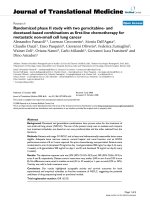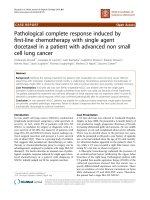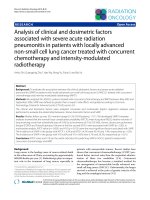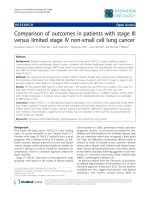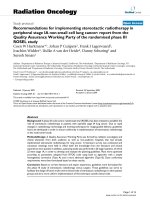Adjuvant chemotherapy versus chemoradiotherapy for small cell lung cancer with lymph node metastasis: A retrospective observational study with use of a national database in Japan
Bạn đang xem bản rút gọn của tài liệu. Xem và tải ngay bản đầy đủ của tài liệu tại đây (554.66 KB, 6 trang )
Urushiyama et al. BMC Cancer (2017) 17:613
DOI 10.1186/s12885-017-3610-0
RESEARCH ARTICLE
Open Access
Adjuvant chemotherapy versus
chemoradiotherapy for small cell lung
cancer with lymph node metastasis: a
retrospective observational study with use
of a national database in Japan
Hirokazu Urushiyama1, Taisuke Jo1*, Hideo Yasunaga2, Yasuhiro Yamauchi1, Hiroki Matsui2, Wakae Hasegawa1,
Hideyuki Takeshima1, Yoshihisa Hiraishi1, Akihisa Mitani1, Kiyohide Fushimi3 and Takahide Nagase1
Abstract
Background: The optimal postoperative treatment strategy for small cell lung cancer (SCLC) remains unclear,
especially in patients with lymph node metastasis. We aimed to compare the outcomes of patients with SCLC and
lymph node metastasis treated with postoperative adjuvant chemotherapy or chemoradiotherapy.
Methods: We retrospectively collected data on patients with postoperative SCLC diagnosed with N1 and N2 lymph
node metastasis from the Diagnosis Procedure Combination database in Japan, between July 2010 and March 2015.
We extracted data on patient age, sex, comorbidities, and TNM classification at lung surgery; operative procedures,
chemotherapy drugs, and radiotherapy during hospitalization; and discharge status. Recurrence-free survival was
compared between the chemotherapy and chemoradiotherapy groups using multivariable Cox regression analysis.
Results: Median recurrence-free survival was 1146 days (95% confidence interval [CI], 885–1407) in the chemotherapy
group (n = 489) and 873 days (95% CI, 464–1282) in the chemoradiotherapy group (n = 75). There was no significant
difference between these after adjusting for patient backgrounds (hazard ratio, 1.29; 95% CI, 0.91–1.84).
Conclusions: There was no significant difference in recurrence-free survival between patients with SCLC and N1-2
lymph node metastasis treated with postoperative adjuvant chemotherapy and chemoradiotherapy. Further
randomized clinical trials are needed to address this issue.
Keywords: Small cell lung cancer, Postoperative therapy, Adjuvant chemotherapy, Adjuvant chemoradiotherapy,
Recurrence-free survival, Clinical epidemiology
Background
Small cell lung cancer (SCLC) comprises 10%–20% of
all lung cancers [1]. However, surgery is not appropriate in most SCLC patients, and only about 5% of
SCLCs are considered to be surgically resectable [2].
In the case of postoperative SCLC with regional
lymph node metastasis, European Society for Medical
Oncology guidelines [3] and Japanese consensus
* Correspondence:
1
Department of Respiratory Medicine, Graduate School of Medicine, The
University of Tokyo, 7-3-1 Hongo, Bunkyo-ku, Tokyo 113-8655, Japan
Full list of author information is available at the end of the article
treatment guidelines recommend adjuvant chemotherapy, with adjuvant chemoradiotherapy as an alternative option, while National Comprehensive Cancer
Network guidelines recommend adjuvant chemoradiotherapy, but also note the lack of any data to support
this recommendation [4]. The rarity of resectable
SCLC means that, to the best of our knowledge, no
prospective studies have compared postoperative adjuvant chemotherapy and chemoradiotherapy in patients
with SCLC, and the optimal treatment thus remains
unclear, especially in patients with regional lymph
node metastasis.
© The Author(s). 2017 Open Access This article is distributed under the terms of the Creative Commons Attribution 4.0
International License ( which permits unrestricted use, distribution, and
reproduction in any medium, provided you give appropriate credit to the original author(s) and the source, provide a link to
the Creative Commons license, and indicate if changes were made. The Creative Commons Public Domain Dedication waiver
( applies to the data made available in this article, unless otherwise stated.
Urushiyama et al. BMC Cancer (2017) 17:613
The aim of this study was to compare the prognosis of
patients with SCLC diagnosed with regional lymph node
metastasis treated with postoperative adjuvant chemotherapy or chemoradiotherapy, using information from a
national inpatient database in Japan.
Methods
Page 2 of 6
using the Kaplan–Meier method and compared between
the groups using log-rank tests. Recurrence-free survival
was compared between the groups by multivariable Cox
regression analysis, after adjusting for patient backgrounds. The threshold for significance was P < 0.05. All
statistical analyses were performed using SPSS version
22.0 (IBM SPSS Inc., Armonk, NY, USA).
Data source
The Diagnosis Procedure Combination (DPC) database
[5] is a national inpatient database in Japan, covering approximately 50% of acute-care inpatients. It includes data
on the following: patient age, sex, body height and weight
(body mass index), primary diagnosis, TNM classification,
Charlson comorbidity index, and Barthel index on admission; operative procedures, chemotherapy drugs, and
radiotherapy during hospitalization; and discharge status.
This study was approved by the Institutional Review
Board of The University of Tokyo. The board waived the
requirement for informed patient consent because of the
anonymous nature of the data.
Patient selection
We retrospectively collected data for patients with SCLC
defined by the International Statistical Classification of Diseases and Related Health Problems-10th revision (ICD-10),
who underwent surgery to remove one or more lung lobe(s)
because of malignant lung cancer, between July 2010 and
March 2015. We excluded patients aged ≤17 years and patients with a history of other cancers at the time of lung surgery. We selected patients who were diagnosed with N1–2
lymph node metastasis at their first adjuvant chemotherapy,
which included agents such as cisplatin, carboplatin, etoposide, or irinotecan, within 3 months after surgery. We further selected patients who received radiotherapy for ≥17
consecutive days within 5 months after surgery. Patients
who received both chemotherapy and radiotherapy were defined as the adjuvant chemoradiotherapy group, and patients who received chemotherapy alone were defined as
the adjuvant chemotherapy group.
Primary outcome
The primary outcome of this study was recurrence-free
survival, defined as the time to any first event including
relapse or death. Relapse was defined as: gamma-knife
therapy starting >3 months after surgery; radiotherapy
starting >9 months after surgery; diagnosis of distant metastasis (ICD-10 codes, C40, C41, C71, C72, C77, C787,
C793 and C797); chemotherapy with the abovementioned four drugs after >9 months; and chemotherapy
with topotecan or amrubicin.
Statistical analysis
Patient characteristics were compared between the
groups using χ2 tests. Survival curves were constructed
Results
Patient characteristics
We identified 564 patients with SCLC who underwent
lung resection followed by adjuvant chemotherapy
(n = 489) or chemoradiotherapy (n = 75) during the
study period. Patient characteristics on admission for
primary chemotherapy after lung surgery are shown in
Table 1. The proportion of women was higher in the
chemotherapy than in the chemoradiotherapy group
(P = 0.038), but there were no significant differences between the groups in any other patient characteristics.
The details of adjuvant chemotherapy are shown in
Table 2. The proportions of patients who received more
than three cycles of adjuvant chemotherapy were 60.8%
in the chemotherapy group and 72.0% in the chemoradiotherapy group. The numbers of cycles of cisplatin or
carboplatin were consistent with the total number of
courses. Totals of 181 patients in the chemotherapy
group and six in the chemoradiotherapy group received
neither etoposide nor irinotecan.
Recurrence-free survival
Median recurrence-free survival was 1146 days (95%
confidence interval [CI], 885–1407) in the chemotherapy
group, 873 days (464–1282) in the chemoradiotherapy
group, and 1120 days (915–1325) in all patients. The
equivalent median recurrence-free survivals in N1 patients were 1484 days (not predictable), 974 days (not
predictable), and 1158 days (756–1560), respectively,
and in N2 patients were 1120 days (831–1409), 596 days
(163–1029), and 983 days (718–1248), respectively.
The Kaplan–Meier curves for recurrence-free survival
are shown in Fig. 1. Recurrence-free survival was significantly longer in the chemotherapy compared with the
chemoradiotherapy group, before adjusting for patient
backgrounds (P = 0.037). However, this difference was not
observed in separate analysis for each N1 (P = 0.27) and
N2 group (P = 0.10).
The results of multivariable Cox regression analysis
for recurrence-free survival are shown in Table 3.
Recurrence-free survival did not differ significantly between the adjuvant chemoradiotherapy and chemotherapy groups (hazard ratio, 1.29; 95% CI, 0.91–1.84) after
adjusting for age, sex, the extent of cancer (T and N factors), body mass index, Charlson comorbidity index, and
Barthel index. Higher Charlson comorbidity index was
Urushiyama et al. BMC Cancer (2017) 17:613
Page 3 of 6
Table 1 Patient characteristics
Chemotherapy group
Chemoradiotherapy group
(n = 489)
(n = 75)
P
Cancer staging
N factor
0.12
N1
243
(49.7)
30
(40.0)
N2
246
(50.3)
45
(60.0)
T factor
0.31
T0–1
203
(41.5)
37
(49.3)
T2
192
(39.3)
21
(28.0)
T3–4
90
(18.4)
16
(21.3)
Tx
4
(0.8)
1
(1.3)
18–49
24
(4.9)
3
(4.0)
50–64
149
(30.5)
22
(29.3)
65–74
242
(49.5)
39
(52.0)
≥ 75
74
(15.1)
11
(14.7)
Age (years)
0.97
Sex
0.038
Male
379
(77.5)
66
(88.0)
Female
110
(22.5)
9
(12.0)
33
(6.8)
7
(9.3)
2
Body mass index (kg/m )
< 18.5
0.83
18.5–24.9
325
(66.5)
48
(64.0)
≥ 25
127
(26.0)
19
(25.3)
Missing
4
(0.8)
1
(1.3)
Charlson comorbidity index
0.32
0–2
316
(64.6)
44
(58.7)
≥3
173
(35.4)
31
(41.3)
Independent (100–95)
465
(95.1)
71
(94.5)
Dependent (≤90)
12
(2.5)
2
(2.7)
Missing
12
(2.5)
2
(2.7)
Activity of daily life (Barthel index)
0.99
Data expressed as number (%) in each group
significantly associated with shorter recurrence-free survival (hazard ratio, 1.81; 95% CI, 1.39–2.35).
Discussion
This study revealed no significant difference in prognosis
between patients with SCLC diagnosed with N1-2 lymph
node metastasis treated with postoperative adjuvant chemotherapy or chemoradiotherapy. To the best of our knowledge, this is the first study to provide evidence of treatment
outcomes in these patients in a nationwide clinical setting.
An earlier study by the National Cancer Institute
using information from the Surveillance, Epidemiology,
and End Results database reported a median survival of
25.0 months in patients with stage II SCLC who underwent lung resection [6]. However, the current study
had the advantage of including information not available in the previous study, including information on
chemotherapy drugs, TNM classification, body mass
index, Charlson comorbidity index, and Barthel index,
thus allowing the prognostic effects of adjuvant chemotherapy and chemoradiotherapy to be compared after
controlling for patient backgrounds. Patients with endstage SCLC are often discharged to home care, hospices, nursing homes, or community hospitals. However, the DPC database only contains records of deaths
occurring in-hospital, and we were therefore unable to
follow-up all deaths outside the participating hospitals
or home care. In the survival analyses of recurrencefree survival, discharge to another hospital or home
was regarded as censored.
Urushiyama et al. BMC Cancer (2017) 17:613
Page 4 of 6
Table 2 Adjuvant chemotherapy
Chemotherapy group
(n = 489)
Chemoradiotherapy group
(n = 75)
Total course (cycles)
1–2
192
(39.3)
21
(28.0)
3–4
256
(52.4)
45
(60.0)
≥5
41
(8.4)
9
(12.0)
Drug (cycles)
Cisplatin or carboplatin
0
0
0.0
2
(2.7)
1–2
197
(40.3)
21
(28.0)
3–4
258
(52.8)
44
(58.7)
≥5
34
(7.0)
8
(10.7)
0
254
(51.9)
18
(24.0)
1–2
84
(17.2)
14
(18.7)
3–4
132
(27.0)
38
(50.7)
≥5
19
(3.9)
5
(6.7)
0
416
(85.1)
63
(84.0)
1–2
31
(6.3)
7
(9.3)
3–4
38
(7.8)
3
(4.0)
≥5
4
(0.8)
2
(2.7)
Etoposide
Irinotecan
Data expressed as number (%) in each group
Some studies have suggested that resected patients receiving adjuvant chemotherapy had more favorable outcomes
than non-resected patients receiving chemoradiotherapy [7,
8], possibly because surgery provides more effective local
control than radiotherapy. The current study showed that
adjuvant chemoradiotherapy had no clinical advantage over
chemotherapy. Therefore, we were unable to demonstrate
the treatment effect of additional radiotherapy in patients
with SCLC who underwent lung resection followed by
adjuvant chemotherapy. The lack of a significant difference
in terms of recurrence-free survival suggests that
chemotherapy alone may be preferable to adjuvant chemoradiotherapy, taking into consideration the potential adverse
effects of chemoradiotherapy [9]. However, the present
study was a retrospective, observational study, and further
randomized clinical trials are needed to address this issue.
The present study also showed that some patients with
SCLC received non-standard primary regimens in clinical practice. Although most patients received at least
one cycle of chemotherapy containing cisplatin or carboplatin, some received neither etoposide nor irinotecan.
This may have been because of the patient’s choice of
chemotherapy drugs, or because of trials of new therapies for SCLC in some hospitals.
There were several limitations of this study associated
with a lack of information on the pathological status of
the dissected lymph nodes, the intent and detailed method
of radiotherapy, and the severity of postoperative symptoms. Furthermore, the selection bias in choosing patients
for adjuvant chemotherapy or chemoradiotherapy was unknown and might have affected the outcomes. Although it
is generally assumed that surgery to remove one or more
lung lobe(s) in patients with malignant lung cancer included complete lung resection and lymph node dissection, if more patients in the adjuvant chemoradiotherapy
group had positive surgical margins or incomplete lymph
node resection, this could have biased the results of our
study against chemoradiotherapy. Furthermore, strong
trends toward better outcomes in N2 patients in the adjuvant chemotherapy group may have been associated with
the smaller number of patients with multiple N2, compared with the chemoradiotherapy group. Data on radiation field, dose, and intent of radiotherapy were also
unavailable in the database. However, adjuvant thoracic irradiation usually comprises ≥15 daily fractions, and
prophylactic cranial and other palliative irradiation usually
involves no more than 10 daily fractions. We therefore defined adjuvant radiotherapy as radiation therapy lasting
≥17 consecutive days, within 5 months after surgery. This
definition of adjuvant chemoradiotherapy was used to try
Fig. 1 Kaplan–Meier curves for recurrence-free survival in postoperative SCLC patients receiving adjuvant chemotherapy or chemoradiotherapy.
a Results for all N1 and N2 patients; b results for only N1 patients; and c results for only N2 patients
Urushiyama et al. BMC Cancer (2017) 17:613
Page 5 of 6
Table 3 Multivariable Cox regression analysis of recurrencefree survival
Hazard ratio
95% Confidence interval
reported a 5-year survival of about 40% in stage II-IIIA
SCLC patients with postoperative adjuvant chemotherapy.
P
Adjuvant therapy
T2
1.11
0.82–1.50
0.50
T3-4
1.09
0.77–1.56
0.63
Conclusions
The present study showed no significant difference in
recurrence-free survival between patients with SCLC
and N1-2 lymph node metastasis treated with postoperative adjuvant chemotherapy and chemoradiotherapy.
However, this was a retrospective study in relatively rare
SCLC cases, and the possibilities of selection bias and
unmeasured confounders mean that the results are inconclusive. Further clinical studies are thus needed to
determine the optimal treatment strategy in patient with
postoperative SCLC.
Abbreviations
CI: Confidence interval; DPC: Diagnosis Procedure Combination; ICD10: International Statistical Classification of Diseases and Related Health
Problems-10th revision; SCLC: Small cell lung cancer
Chemotherapy
Reference
Chemoradiotherapy
1.29
0.91–1.84
0.15
0.94–1.59
0.14
N factor
N1
Reference
N2
1.22
T factor
T0-1
Reference
Age (years)
18–49
Reference
50–64
1.27
0.62–2.59
0.51
65–74
1.27
0.64–2.55
0.50
≥ 75
1.46
0.69–3.09
0.33
Acknowledgements
Not applicable.
Availability of data and material
Patient data cannot be made publicly available for ethical reasons. However,
the data are available to interested researchers upon request to the
corresponding author, pending ethical approval.
Sex
Male
Reference
Female
0.77
0.54–1.10
0.15
< 18.5
1.42
0.87–2.31
0.16
18.5–24.9
Reference
≥ 25
1.30
0.96–1.75
0.09
1.39–2.35
<0.001
2
Body mass index(kg/m )
Charlson comorbidity index
0–2
Reference
≥3
1.81
Activity of daily life (Barthel index)
Independent
(100–95)
Reference
Dependent (≤90)
1.80
0.87–3.75
0.12
and exclude most other palliative radiotherapies. The first
course of chemotherapy or chemoradiotherapy for patients with SCLC is generally administered during
hospitalization in Japan. Thus, most postoperative SCLC
patients treated with adjuvant chemotherapy or chemoradiotherapy were likely to be included in our study. Patients may be followed up at the same hospital where they
underwent lung resection, and may be admitted to the
same hospital for examination and treatment of cancer relapse. This study may therefore have captured the initiation of chemotherapy or chemoradiotherapy and cancer
relapse adequately, though lack of outpatient data may
have biased the results.
Despite these limitations, recurrence-free survival in the
adjuvant chemotherapy group in our study was similar to
that in a previous prospective study [7], which also
Funding
This work was supported by grants from the Ministry of Health, Labour and
Welfare, Japan (H29-Policy-Designated-009 and H29-ICT-Genral-004); Ministry
of Education, Culture, Sports, Science and Technology, Japan (17H04141);
and the Japan Agency for Medical Research and Development (AMED). The
funding bodies had no role in the design of the study and collection,
analysis, and interpretation of data and in writing the manuscript.
Authors’ contributions
HU: study design, data analysis, data interpretation, and manuscript
preparation. TJ: study design, data analysis, data interpretation, and
manuscript preparation. HY: study design, data collection, data analysis,
data interpretation, and manuscript preparation. YY: data analysis, and
data interpretation. HM: data collection, data analysis, and data
interpretation. WH: study design and data interpretation. HT: study
design and data interpretation. YH: study design and data interpretation.
AM: study design and data interpretation. KF: data collection and data
interpretation. TN: study design, data interpretation, and supervision of
the study. All authors approved the final manuscript.
Ethics approval and consent to participate
Conduct of the study was approved by the Institutional Review Board of The
University of Tokyo, which waived the requirement for informed consent
owing to the anonymity of the data. Approval for the use of the data was
obtained from the Diagnosis Procedure Combination Study Group.
Consent for publication
Not applicable.
Competing interests
The authors declare that they have no competing interests.
Publisher’s Note
Springer Nature remains neutral with regard to jurisdictional claims in
published maps and institutional affiliations.
Urushiyama et al. BMC Cancer (2017) 17:613
Page 6 of 6
Author details
1
Department of Respiratory Medicine, Graduate School of Medicine, The
University of Tokyo, 7-3-1 Hongo, Bunkyo-ku, Tokyo 113-8655, Japan.
2
Department of Clinical Epidemiology and Health Economics, School of
Public Health, The University of Tokyo, 7-3-1 Hongo, Bunkyo-ku, Tokyo
113-8655, Japan. 3Department of Health Policy and Informatics, Graduate
School of Medicine, Tokyo Medical and Dental University, 1-5-45 Yushima,
Bunkyo-ku, Tokyo 113-8510, Japan.
Received: 29 November 2016 Accepted: 24 August 2017
References
1. Govindan R, Page N, Morgensztern D, Read W, Tierney R, Vlahiotis A,
Spitznagel E, Piccirillo J. Changing epidemiology of small-cell lung cancer in
the United States over the last 30 years: Analysis of the surveillance,
epidemiologic, and end results database. J Clin Oncol. 2006;24:4539–44.
2. Ignatius Ou S-H, Zell JA. The applicability of the proposed IASLC staging
revisions to small cell lung cancer (SCLC) with comparison to the current
UICC 6th TNM Edition. J Thorac Oncol. 2009;4:300–10.
3. Früh M, De Ruysscher D, Popat S, Crinò L, Peters S, Felip E. Small-cell lung
cancer (SCLC): ESMO clinical practice guidelines for diagnosis, treatment
and follow-up. Ann Oncol. 2013;24(Supplement 6):vi99–vi105.
4. National Comprehensive Cancer Network®. NCCN Clinical Practice Guidelines
in Oncology (NCCN Guidelines®) Small Cell Lung Cancer Version 2. 2017.
/>5. Yasunaga H, Matsui H, Horiguchi H, Fushimi K, Matsuda S. Clinical
epidemiology and health services research using the Diagnosis Procedure
Combination Database in Japan. Asian Pacific J Dis Manag. 2013;7:19–24.
6. Weksler B, Nason KS, Shende M, Landreneau RJ, Pennathur A. Surgical
resection should be considered for stage I and II small cell carcinoma of the
lung. Ann Thorac Surg. 2012;94:889–93.
7. Tsuchiya R, Suzuki K, Ichinose Y, Watanabe Y, Yasumitsu T, Ishizuka N, Kato
H. Phase II trial of postoperative adjuvant cisplatin and etoposide in patients
with completely resected stage I-IIIa small cell lung cancer: the Japan
Clinical Oncology Lung Cancer Study Group Trial (JCOG9101). J Thorac
Cardiovasc Surg. 2005;129:977–83.
8. Stinchcombe TE, Gore EM. Limited-stage small cell lung cancer: current
chemoradiotherapy treatment paradigms. Oncologist. 2010;15:187–95.
9. Warde P, Payne D. Does thoracic irradiation improve survival and local
control in limited-stage small-cell carcinoma of the lung? a meta-analysis. J
Clin Oncol. 1992;10:890–5.
Submit your next manuscript to BioMed Central
and we will help you at every step:
• We accept pre-submission inquiries
• Our selector tool helps you to find the most relevant journal
• We provide round the clock customer support
• Convenient online submission
• Thorough peer review
• Inclusion in PubMed and all major indexing services
• Maximum visibility for your research
Submit your manuscript at
www.biomedcentral.com/submit
